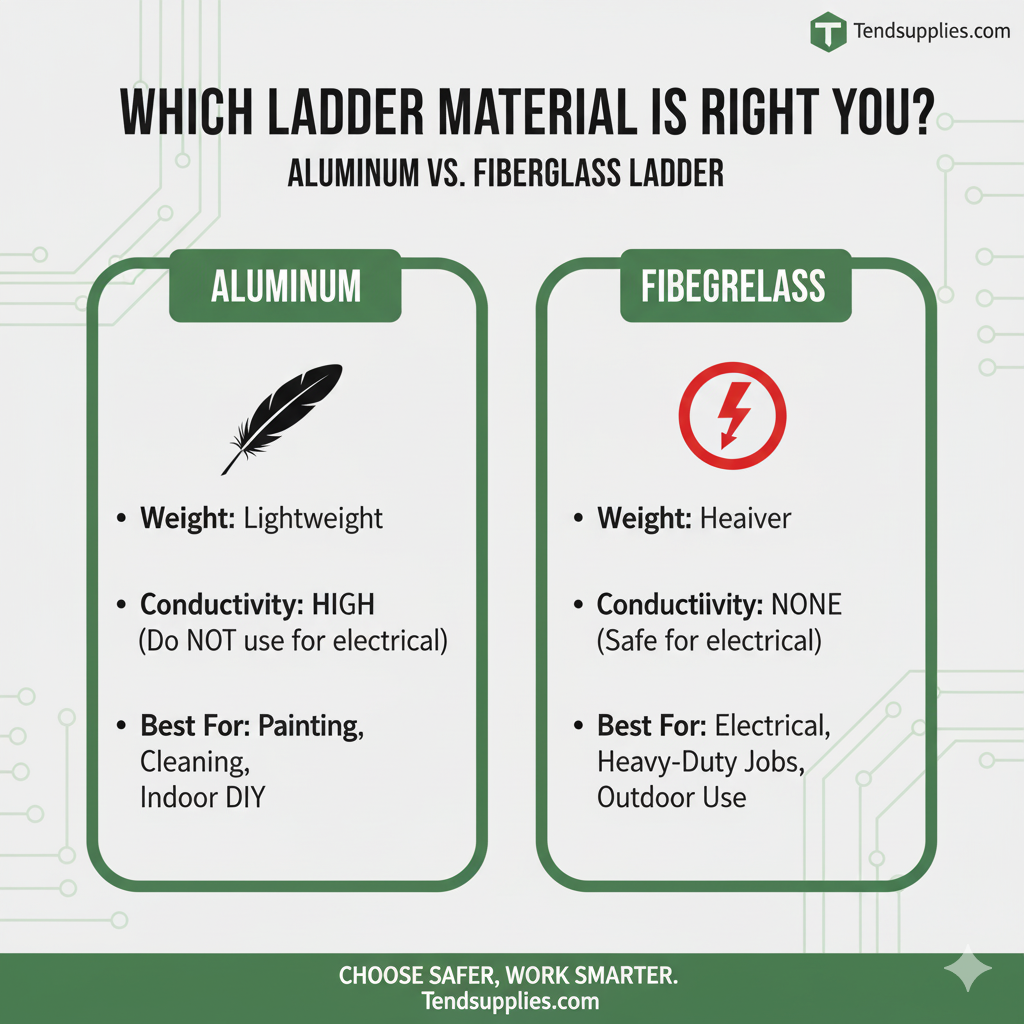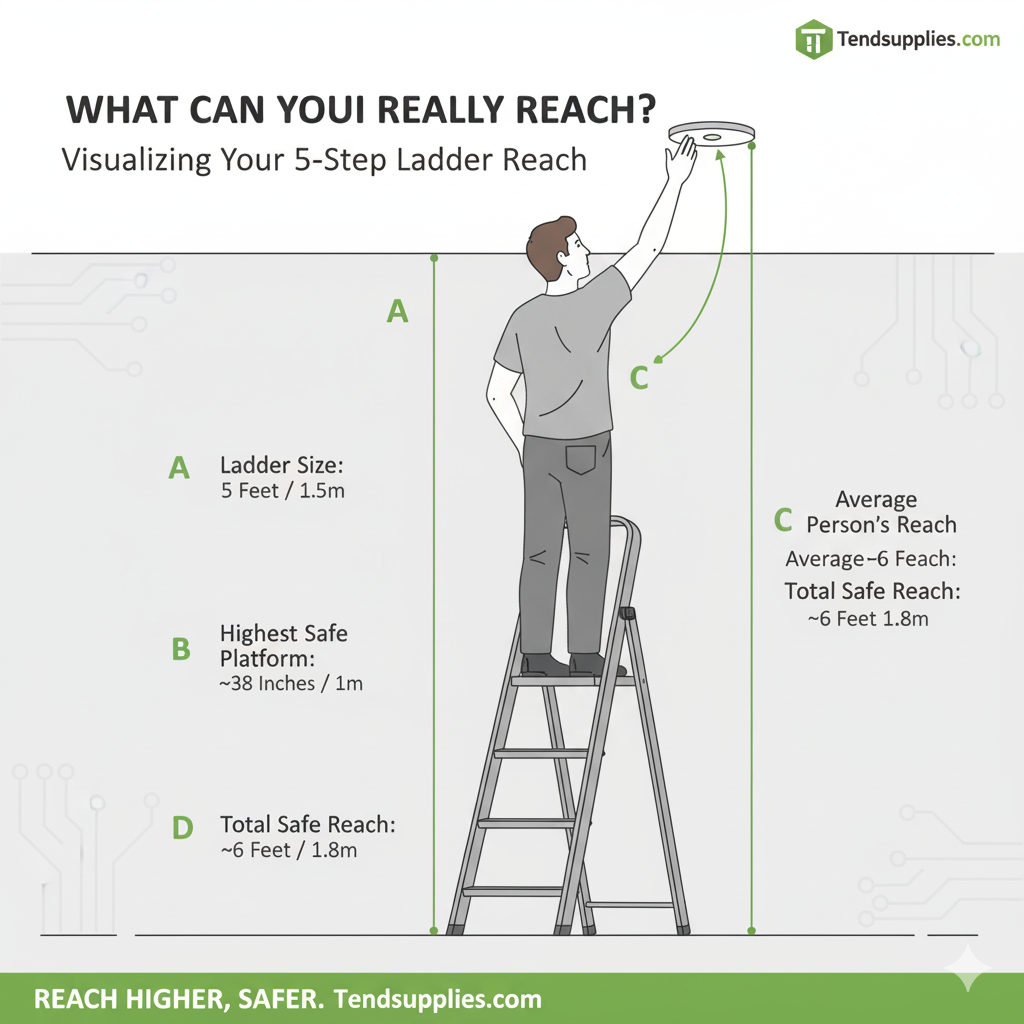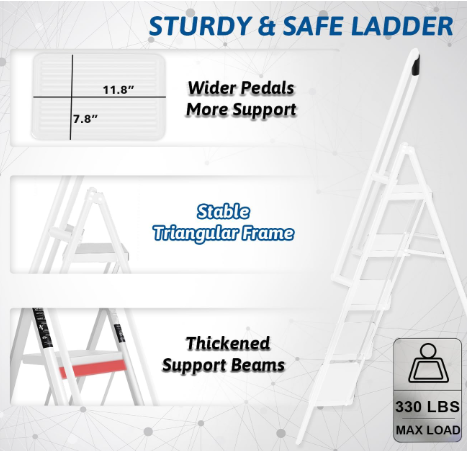The Ultimate Height Guide: What You Can Reach with a 5 Step Folding Ladder
Last weekend, Mr Damian decided it was finally time to repaint his living room ceiling. Armed with a paint roller and his old 3-step stool, he thought he had everything he needed. But a few minutes in, he was already on his toes, stretching, wobbling, and realizing he couldn’t quite reach the corners. Frustrated, he switched to a bulky 8-foot ladder from the garage, only to find it too tall and heavy for indoor use.
That’s when he discovered the perfect middle ground: a 5-step folding ladder. Lightweight enough to move from room to room, yet tall enough to reach every inch of his 9-foot ceiling, without a hint of strain or risk.
Finding the right ladder height can be surprisingly confusing. Too short, and you’re left stretching uncomfortably to reach that final spot. Too tall, and you’re wrestling with a heavy, oversized frame that’s awkward to store or move around the house. For most homeowners, the 5-step folding ladder, also known as a 5-foot A-frame ladder, hits the perfect balance between height, stability, and portability.
But here’s the big question: What can you actually reach with a 5-step ladder? Can you safely paint a 9-foot ceiling? Replace that hallway light fixture? Or clean the top of your kitchen cabinets without wobbling?
This 5-step ladder reach guide reveals how much height you truly gain, which home projects it handles best, and when it’s time to go taller. Whether you’re tackling DIY repairs, painting ceilings, or changing light fixtures, you’ll learn how to make every climb safe, efficient, and confidence-inspiring.
Amazon Affiliate Disclosure:
Tend Supplies is a participant in the Amazon Services LLC Associates Program, an affiliate advertising program designed to provide a means for sites to earn fees by linking to Amazon.com and affiliated sites. As an Amazon Associate, we earn from qualifying purchases. We only recommend products we genuinely believe in, which helps us continue to create valuable content for our readers.
Key Takeaways:
- Your True Reach: A standard 5-step (or 5-foot) folding ladder gives an average person a maximum safe working reach of 9 to 10 feet (approximately 2.7 to 3 meters).
- The "Highest Safe Standing Level": This reach is calculated by standing on the correct step, the third step from the bottom. You must NEVER stand on the top cap or the step directly below it.
- The "Sweet Spot" for Tasks: This ladder is the perfect height for homes with standard 8-foot and 9-foot ceilings, making it ideal for painting, changing lightbulbs, cleaning ceiling fans, and accessing high cabinets.
- Know Its Limits: A 5-step ladder is NOT tall enough for comfortably working on 10-foot ceilings, and it is completely unsafe for vaulted ceilings, second-story gutters, or exterior painting.
- Safety & Material First: Always choose fiberglass (non-conductive) for any electrical work. For all other tasks, lightweight aluminum is a good choice, but always check the ladder's weight rating (e.g., Type I, 250 lbs) to ensure maximum stability.
The "Reach Height" Formula: How We Get the 10-Foot Answer
Your "maximum reach" isn't just the height of the ladder. It's a simple, safety-first calculation. Understanding this formula is the key to buying the right ladder for any job, anywhere in the world.
Step 1: Understanding "Ladder Height" vs. "Platform Height"
This is the single most confusing part of buying a ladder.
- "Ladder Height" (e.g., "5-Foot Ladder"): In many countries, particularly the U.S., step ladders are sold by their total height in feet when in the A-frame position. A "5-foot ladder" is 5 feet tall from the ground to its top cap.
- "Step Count" (e.g., "5-Step Ladder"): In other markets, they are sold by the number of steps, including the top cap. A "5-step ladder" almost always refers to a 5-foot A-frame ladder.
For this guide, we'll treat "5-step ladder" and "5-foot A-frame ladder" as the same product, which is the industry standard.
See our Guide on: 5 Reasons Why Every Home Needs a Folding Step Ladder with Handrails
The most important number isn't 5 feet. It's the Platform Height, the height of the highest step you are safely allowed to stand on.
Step 2: The "Highest Safe Standing Level" Rule
On any A-frame step ladder, you should NEVER stand on the top step (the "top cap") or the step directly below it. The top cap is for tools (or a tool bag), and the step below it is for balance. Standing higher than this removes your center of gravity, eliminates any part of the ladder to hold onto, and is the primary cause of serious falls.
- On a 5-step ladder, the Highest Safe Standing Level is the 3rd step from the bottom.
- The typical height of this step is approximately 38 inches (96 cm), or just over 3 feet.
Step 3: Calculating Your Maximum Safe Reach
Now, we just do the math. This formula is used by ladder manufacturers and safety organizations worldwide.
(Highest Safe Standing Height) + (Average Person's Overhead Reach) = Maximum Safe Reach
- Standing Height: ~38 inches (or 3.2 feet / ~1 meter)
- Average Reach: ~6 feet (or 1.8 meters). This assumes an average-height person (5'9" or 175 cm) with a 12-inch (30 cm) overhead reach.
The Calculation: 3.2 feet (platform) + 6 feet (person) = 9.2 feet
This is why we confidently say a 5-step ladder gives you a maximum safe working reach of 9 to 10 feet (2.7 to 3 meters). Shorter individuals may top out at 9 feet, while taller individuals can comfortably reach 10 feet.
What Tasks Are PERFECT for a 5 Step Ladder? (The 9-10 Foot "Sweet Spot")
With a clear 9-10 foot reach, the 5-step ladder becomes the undisputed champion for homes with standard 8-foot and 9-foot ceilings.
Essential Indoor Household Tasks
This ladder is your best friend for 90% of indoor maintenance.
- Painting and "Cutting In": It's the perfect size for "cutting in", painting the line where your walls meet a standard 8 or 9-foot ceiling. You're at a comfortable, stable working height for hours.
- Changing Lightbulbs: Easily reach ceiling fixtures, recessed lighting, and high-hats in 8 and 9-foot rooms.
- Replacing Smoke Detectors: Safely reach and work on ceiling-mounted smoke detectors and carbon monoxide alarms.
- Cleaning and Dusting: This is the best ladder for cleaning ceiling fans, high shelves, picture rails, and the tops of window frames.
- Accessing High Storage: Ideal for safely retrieving items from the top shelves of kitchen cabinets, pantry shelving, or bedroom closets.
- Hanging Decor: Perfect for installing curtain rods, hanging pictures, or putting up holiday decorations without over-reaching.
Practical Outdoor and Garage Tasks
The 5-step ladder's utility doesn't stop at the door. Its lightweight nature makes it easy to carry around.
- Cleaning First-Floor Gutters: For a typical single-story home, a 5-step ladder is often just tall enough to let you safely reach and clean out gutters. (Caution: Always ensure the ground is perfectly level).
- Washing Windows: Easily reach the top of all first-floor windows.
- Accessing Garage Shelving: Retrieve storage bins, tools, and supplies from high garage shelving units.
- Minor Landscaping: Safely prune tall shrubs, train climbing vines, or water high-hanging baskets.
When is a 5 Step Ladder TOO Short? (Know Your Limits)
Knowing what not to do with a ladder is just as important as knowing what to do. A 5-step ladder is NOT the right tool for these jobs.
- Working on 10-Foot Ceilings: While you can reach a 10-foot ceiling to change a single lightbulb, you cannot work at that height. For painting, patching, or installing a fixture on a 10-foot ceiling, you will be uncomfortably (and unsafely) stretching. You need a 6-step or 8-step ladder.
- Vaulted or Cathedral Ceilings: Any room with ceilings above 10 feet is completely out of the question.
- Cleaning Second-Story Gutters: NEVER use a step ladder for this. This task requires a tall extension ladder.
- Exterior Painting (Second Story): This also requires a much taller extension ladder.
- Accessing Most Attics: While some attic scuttles are in 8-foot hallways, many are in 9-foot or 10-foot ceilings, which would require a taller ladder for safe entry.
Choosing Your 5-Step Ladder: Materials and Features
Now that you know what a 5-step ladder can do, here’s how to choose the right one.
Material Matters: Aluminum vs. Fiberglass
This is the most important choice you'll make.
- Aluminum:
- Pros: Extremely lightweight, easy to carry, and resists rust/corrosion. This is the most popular choice for general household use.
- Cons: It conducts electricity. You should NEVER use an aluminum ladder when working on or near live electrical wiring.
- Best For: Painting, cleaning, organizing, and general DIY.
- Fiberglass:
- Pros: Non-conductive. This is the only choice for electricians or any DIY electrical work (like changing a light fixture). It's also extremely durable and weather-resistant.
- Cons: Noticeably heavier than aluminum and slightly more expensive.
- Best For: All electrical work, heavy-duty projects, and outdoor use.

Duty Rating & Weight Capacity (A Global Standard)
Ladders are rated for the total weight they can safely hold (you + your tools). Look for these ratings, which are standardized by groups like ANSI (USA) or EN 131 (Europe).
- Type III (Light Duty): 200 lbs / 90 kg. Fine for a small, lightweight person doing quick tasks.
- Type II (Medium Duty): 225 lbs / 102 kg. Good for most homeowners.
- Type I (Heavy Duty): 250 lbs / 113 kg. A solid, stable choice for most users.
- Type IA (Extra Heavy Duty): 300 lbs / 136 kg. The professional standard offers maximum stability.
Pro-Tip: Always buy a ladder rated for more than you weigh. A Type I or Type IA ladder will feel significantly more stable and secure, which is worth the small extra cost.
Must-Have Features for Modern Ladders
- Integrated Tool Bag / Project Tray: (As covered in our other guide!) A top cap with slots for a hammer, drill, screws, and a rag is incredibly efficient.
- Wide, Non-Slip Steps: Deeper, grooved steps are much more comfortable and secure than narrow rungs.
- One-Handed Fold Mechanism: A simple pull-handle or latch makes opening and closing the ladder much less of a chore.
- Non-Marring Feet: Rubber or plastic feet that won't scuff your hardwood or tile floors.

The Golden Rules: How to Use Your 5-Step Folding Ladder Safely
You can have the right ladder and still get hurt. Always follow these non-negotiable safety rules.
- Inspect Before Use: Every single time. Check for loose rivets, cracked steps, or damaged (or missing) rubber feet.
- Use on Level Ground: Only use your ladder on a firm, flat, and level surface. Never use it on soft dirt, a sloped driveway, or by propping one leg up on a book.
- Lock the Spreader Bars: Open the A-frame completely and ensure the two metal spreader bars are fully extended and locked into place.
- Obey the 3-Point Contact Rule: When climbing or descending, always maintain three points of contact: two feet and one hand, or one foot and two hands.
- NEVER Stand on the Top Cap: We'll say it again. The highest safe standing level is the third step.
- The "Belt Buckle" Rule: Keep your hips (and belt buckle) centered between the ladder's side rails. If you have to overreach, you're not close enough. Climb down and move the entire ladder.
- Face the Ladder: Always face the rungs when going up or down. Never try to walk down it as if it were a staircase.
Also Read: Top 7 Safety Tips For Using a Folding Step Ladder with Handrails
Frequently Asked Questions (FAQs)
- What is the maximum height I can safely reach with a 5-step ladder? A 5-step (or 5-foot) folding ladder provides an average-sized person with a maximum safe working reach of 9 to 10 feet (about 2.7 to 3 meters). This is calculated by adding the ladder's highest safe standing level (approx. 3.2 feet) to an average person's overhead reach (approx. 6 feet).
- Is a "5-step ladder" the same thing as a "5-foot ladder"? Yes, in most cases. In the industry, these terms are used interchangeably to describe an A-frame ladder that is approximately 5 feet (1.5m) tall from the ground to its top cap and has five steps, including that top cap.
- What is the highest step I am allowed to stand on? The highest safe standing level on a 5-step ladder is the third step from the bottom. You must NEVER stand on the top cap or the step directly below it. Standing any higher removes your center of gravity, eliminates your ability to hold on, and is a primary cause of falls.
- Is a 5-step ladder tall enough to paint a 9-foot ceiling? Yes. This is the perfect "sweet spot" for a 5-step ladder. It allows you to stand on the correct step and comfortably reach an 8-foot or 9-foot ceiling for tasks like painting, "cutting in," changing fixtures, or cleaning.
- Can I use a 5-step ladder for a 10-foot ceiling? It is not recommended. While you might be able to barely reach a 10-foot ceiling (e.g., to touch a smoke detector), you cannot work at that height safely or comfortably. For painting or any extended work on a 10-foot ceiling, you need a 6-step or 8-step ladder.
- Should I buy an aluminum or a fiberglass 5-step ladder? This depends on your tasks. Choose fiberglass if you will be doing any electrical work (like changing light fixtures or ceiling fans), as it does not conduct electricity. Choose aluminum if you only need a lightweight ladder for general tasks like painting, cleaning, or organizing, as it's much easier to carry.
- Is a 5-step ladder safe for cleaning gutters? Only for a single-story house and only if the ground is perfectly firm and level. You must never over-reach. It is completely unsafe and not tall enough for cleaning second-story gutters, which requires a much taller extension ladder.
Related Articles:
- Best Telescoping & Folding Ladders 2025 | Top 7 Picks & Deals
- A Comprehensive Guide to Different Types of Ladders and Their Benefits
- Choosing the right ladder for your project
- The Top 10 Types of Ladders for Every Homeowner in 2025
SHOP Double Elite Step Ladder 5 Step Folding with Handrails on Amazon
Conclusion
So, what can you reach with a 5-step folding ladder? The final verdict is clear: it is the most versatile and essential height-access tool for the vast majority of homeowners. Its true value lies in mastering that 9-to-10-foot "sweet spot."
This makes it the undisputed champion and the perfect ladder for 9-foot ceilings, as well as standard 8-foot ones. It empowers you to confidently tackle the most common household tasks for a 5-step ladder, from painting and cleaning ceiling fans to changing lightbulbs and organizing high-storage shelves.
However, choosing the right step ladder size is just as much about knowing its limitations. This ladder is not the safe choice for working on 10-foot ceilings, tackling vaulted rooms, or any second-story exterior work.
By understanding the correct safe ladder standing height (never the top two steps) and making the smart choice between an aluminum vs. fiberglass step ladder based on your projects, your 5-step ladder becomes a powerful tool for efficiency. It is the perfect, practical solution for everyday reach, landing squarely in the "just right" zone for most modern homes.
Call to Action
Ready to find the perfect ladder that hits that 9-to-10-foot "sweet spot"? Don't settle for "close enough." Get the right tool for the job and tackle your home projects with the safety and efficiency you deserve.
Find your ideal 5-step folding ladder, available in both lightweight aluminum and non-conductive fiberglass, by browsing our complete, safety-rated collection at Tendsupplies.com.
Need help choosing the right ladder type or duty rating? For expert advice or to inquire about bulk orders for your business, contact our support team today at sales@tendsupplies.com.











